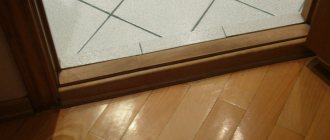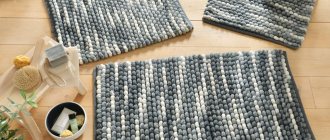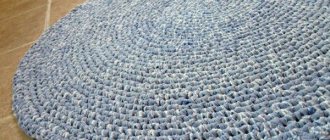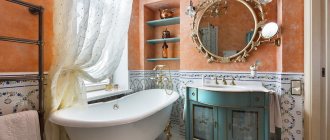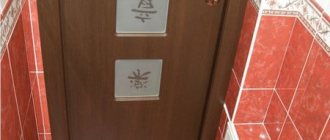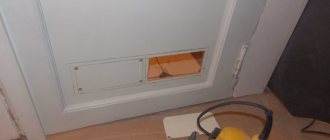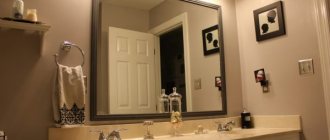( 1 votes, average: 5.00 out of 5)
Painting on the walls is the oldest method of decorating a cave, known since the Stone Age. With the advent of new technologies, people began to create certain templates, according to which the drawing could be reproduced the required number of times, quickly and with high accuracy. However, the difficulty of making samples has limited their widespread use.
However, in the computer age, everything has changed. You can get stencils for any type of bathroom wall, inexpensively and quickly.
What templates there are and how to work with them are further in the article.
Application
Decorative stencils make it possible to achieve the same effect as vinyl stickers. However, they have a significant difference - they are applied to any surface, even rough ones. As a rule, they are used on a single-color base. Multiple colors can be used to create more vibrant images. In this case, it is better to use quick-drying compounds so as not to wait a long time before applying new paint.
Stencils are a plastic sheet or paper on which a design is cut out. With their help, you can apply an image with acrylic paints. For walls, you can choose a stencil of any style. In addition, using the same pattern in different conditions can give different results, because it depends on the lighting, background, method of application, and so on.
The size of the drawings may vary. If you need to apply a large design, you may need several stencils.
Where to place the image
Once you have chosen an ornament or design, you need to decide where in the room to place it. Don't get carried away and apply it to all surfaces. The result will be disastrous.
For decoration, you should choose only a part of the wall or a corner free from furniture
Advice! Often, a stencil image is applied not so much for beauty, but rather to hide a coating defect. For example, if a child painted wallpaper after a recent renovation. In order not to re-glue the entire wall, you can apply a stencil pattern to the damaged area.
If the purpose of the image is to decorate the surface, it is worth thinking through the future plot to the smallest detail. You can prepare unique stencils (templates) for decoration with your own hands.
For example, in the bedroom above the bed you can put an image of birds or butterflies.
The inclusion of furniture in the composition is considered especially chic. The template is not difficult to make with your own hands, but before work you need to take into account several important points:
Kinds
Nowadays, creating a stencil is not difficult even for an ordinary user. But previously, such a procedure took a lot of time, so it was used much less often.
Stencils for decoration can be divided into the following types:
- Simple. In this case, single-color images are created.
- Combined. The stencil consists of several layers, thanks to which you can get multi-color designs. One layer of stencil - one paint.
- Reverse. In this case, paint is applied around the slots, resulting in something like a negative drawing.
- Volumetric. The picture turns out three-dimensional. For this, a polymer film is used. To give the image volume, putty is put into the slots.
DIY stencils for decor
When making your own stencil for decoration, it is advisable to use a thick film, especially if your drawing is a pattern, because it will have to be repeated many times. This material is less susceptible to deformation than others. For one-time application, cardboard is quite suitable.
It is important that when stenciling the paint has a fairly thick consistency and does not spread. When applying a small pattern or decorating small interior items, it is advisable to use a foam sponge; in other cases, a roller will do, especially if the pattern is being made on the walls.
It is highly undesirable to use a brush, which is more likely to not only ruin the stencil, but also smudge the design itself.
Choice
There are several options for how you can get a drawing:
- you need to find a photo of the pattern or draw it, print it and cut it out yourself;
- purchase a ready-made sample;
- order a product from a specialized enterprise;
To obtain a stencil you will need colored or transparent vinyl film.
What are templates for?
Surely many of you have seen interesting sets with ready-made stencils for walls in construction and furniture stores. Plant, animal, and fairy-tale ornaments enliven walls and wallpapers and add zest to the interior and any environment.
A stencil and template can be useful for various decorative works: in the kitchen, children's room, on the ceiling. They create an unusual space, add volume and depth to the surface, realize the creative skills of the owners, and inspire unusual solutions. You can use stencils to add some flair. This is an economical way to bring something new to the look of a room without a large investment. You can create a unique template yourself - then the value of the drawing increases significantly.
You can use templates not only for home decoration, but also for other purposes:
- creating creative cards, posters;
- decorating paintings with vignettes and corners;
- for the purpose of creating calligraphic compositions;
- for congratulations and holiday collages, captions for photographs.
Preparing the stencil
You will need:
- film;
- sketch;
- pencil or marker;
- sharp knife.
The drawing should be copied onto film, then the image should be cut out along the contour. In this case, you should choose simple pictures, without small elements. Another thing is professional equipment that allows you to create a wide variety of stencils for the bathroom. A cutting plotter is used for this.
It should be noted that the created stencil must first be tested by applying the image to paper using it. This will confirm that the final image is applied correctly. Such a test will not take much time, even if the drawing is multi-colored, because acrylic paint is used for this.
How to make a stencil at home
Preparatory stage
The first step is to choose or come up with a sketch. You can develop it yourself or print a ready-made template from the Internet. A large sketch is made on a printer in parts, which are then glued together with tape.
The second important step in preparing for work is to select the material for cutting the sample. It is rational to make a plain template from paper or cardboard. It is more practical to make a reusable one from plastic.
In order to make your own stencils, you need to prepare:
- sketch of the drawing (with clearly drawn elements),
- material for cutting out design elements (paper, film, cardboard, plastic),
- soft pencil and thin marker,
- scissors,
- sharp knife,
- roll of tape,
- paper clips,
- a substrate made of smooth material (so as not to spoil the tabletop).
Making a stencil
Usually, single-layer stencils are made at home to decorate smooth surfaces. With this simple technique you can refresh the interior of a room, kitchen or bathroom. You can decorate not only the walls, but also the floor or ceiling with ornaments.
The technology of work can be mastered using the example of how to make a stencil for walls.
A guide to making a single-layer paper stencil.
- First of all, it is necessary to clearly mark the lines of the drawing on the sketch. It is important that the gaps between future slots on the template (walkways) are wide enough. Otherwise, the paint may bleed through and ruin the pattern.
- The image must be carefully transferred to the template base. It is convenient to use carbon paper or tracing paper. To prevent the sheets from shifting when copying a design, the parts must be secured with paper clips or tape.
- The transferred drawing must be carefully examined so that all the lines are clearly visible on the base. If necessary, highlight the elements of the drawing more clearly to facilitate further work.
- Carefully cut out the stencil. Remove all errors and burrs, carefully cut out all sharp corners, otherwise they will negatively affect the final result.
- The easiest way to make a stencil for walls is from paper or cardboard. For strength, it is recommended to cover it with cling film or tape. Then the paint will not be absorbed into the paper, and the bridges (lintels) will not be deformed during operation.
Using this algorithm of actions, you can make templates for decorating a room, applying patterns to textiles and various objects.
When planning to reuse the template, it is better to make it from strong cardboard (covered with tape) or plastic.
Making a plastic stencil with your own hands
The material you can choose is acetate plastic or Mylar. Both types are sold in sheets or rolls. Sometimes they have an adhesive backing. It is better to give preference to a material with a matte surface, as it is more convenient to draw on. You can also take old X-rays.
- A marker is best for drawing a design on a plastic base. The lines should be clear and thin enough so that the design is not distorted when cutting out the template.
- Success in making a stencil will be ensured by a smooth surface and a comfortable, sharp knife. The work is done carefully; it is more convenient to attach the edges of the plastic with tape (or glue) to the base for cutting. This will make working with plastic easier.
- After cutting, it is more convenient to remove small elements of the design with sharp corners using tweezers.
- The edges of all slots should be lightly sanded with fine sandpaper. They must be smooth, otherwise the applied pattern will look blurry.
- After sanding, the plastic template must be cleaned of dust and traces of glue.
- A plastic stencil can be used many times; it is stronger than a cardboard one and can be easily cleaned of adhered paint.
A multilayer stencil is made in exactly the same way, but one for each color.
How to make a flip flop stencil
This technology of drawing a portrait belongs to a fashionable trend in art. Using it, anyone can create a portrait with their own hands, without knowing how to draw.
For work, several shades of paint and a special film are used.
- The picture is retouched using a photo editor to obtain a clear image without glare.
- The image is transferred to a special film with an adhesive backing.
- Stretch the canvas onto a frame, apply primer to it and let it dry.
- Paste a film with an image and color it.
- After the coating has dried, the film is removed.
The portrait remains on the fabric; in this case, the role of the template is played by the film.
It is very difficult to do such work with your own hands without a special film. The film can be purchased at art stores or ordered from a printing house.
The finished film must be secured to a flat surface (for example, on a wall) using tape. Then paint with paints. You can paint with acrylic paint or aerosol paint from a spray can.
The result is a unique portrait made using the most modern technologies.
A hand-made stencil will help give the interior individuality and implement any creative solutions. It’s not difficult to make it yourself, and the result will delight the craftsman and pleasantly surprise the guests.
Drawing
You will need:
- stencil;
- glue to secure the stencil;
- masking tape to protect the surrounding surface;
- brush, roller or sponge.
Before application, the surface must be cleaned and degreased. Next, the stencil is glued in the bathroom in a certain place. Then paint is applied. The layer should dry, after which you can make another one, if necessary. Then the stencil can be removed.
Which paint to choose and how to apply it
You can draw on concrete, wooden, plastered, plasterboard walls, as well as on wallpaper for painting. Wallpaper absorbs paint better, so it will take more paint than on a painted surface. Depending on the type of surface, the appropriate paints are selected:
- Water-based acrylic
- for wood, cardboard, wallpaper, concrete. - Latex
- concrete, gypsum concrete, plaster.
Construction stores sell paints mainly in standard packaging - 1-3 kg, so it is better to look in art stores/on specialized websites.
Painting is done in any convenient way:
- Hand brush with short bristles.
- Roller
. - Sponge
. - Airtograph
.
Unlike aerosol paints, which have a wide jet, airbrushes are much more convenient to use, but they also cost money. You don’t have to think about how to create halftones, and you don’t have to cover a large area of the wall from splashing.
How to draw
The golden rule for stenciling is that the tool should be semi-dry. Having dipped the brush (roller/sponge) into the paint, you need to squeeze it out - roll it over a sheet of paper so that it is semi-dry.
The paint is rolled out with a roller, but with a brush/sponge they are painted with tapping movements, as if driving in the paint, no up and down movements. Hold the brush perpendicular to the wall. To saturate the color, the driving procedure is repeated.
Alternative to stencil decoration
For example, instead of using a stencil, you can use the decoupage technique, which will require:
- multi-layer napkins;
- PVA glue;
- brushes;
- acrylic lacquer;
- scissors.
The procedure is performed as follows. Cut out the desired decor from napkins. We remove their lower layers, and the cut out pattern is applied to the bathroom wall. Next, glue is applied with a brush. When it dries, you can varnish the surface.
The main thing in this matter is desire, then you can decorate the walls of any bathroom in a non-standard and attractive way. Additionally, you can look at the proposed photos, which will allow you to choose the most optimal option.
Where to start: preparing materials
Decide on a pattern that will serve as the basis. The pattern should be selected based on the overall style of the room. Thus, abstract or geometric images will look much better in a high-tech living room than in a rococo room.
If you're going to use a ready-made stencil, which you can buy at most hardware stores, it's up to you. But the drawing for which you created the stencil yourself will be much more interesting and unique! Those of you who are good at drawing can design it yourself. If you are only familiar with the art of drawing by hearsay, it is better to trust patterns found on the Internet and printed on a printer.
Advice!
Patterns for stencils can be any, but it is better to avoid designs with too small details: there is a high probability that the paint will flow beyond the boundaries of an element that is too small. In addition, it is quite possible that from a distance the small details of the design will look illegible and sloppy.
When the drawing is ready, you will need to decide on the stencil material. Most often, thick cardboard or plastic is used. These materials are dense enough to avoid accidental ruptures of the thin partitions between the details of the design. Plus, they don't bleed through paint, get wet, or curl up. You can also use paper, but in this case it is recommended to laminate the finished stencil - this will help protect against paint absorption and will allow you to use it more than once.
Gallery
Drawings on walls were made long before our era. Hundreds of years later, rock paintings make the “interior” of caves not only attractive, but also unique.
Nothing has changed. Well-chosen and properly executed wall painting will help transform the room.
A stencil print on the wall is an easy way to achieve the required zoning of space. By making small changes, you can hide the disadvantages of the layout or, conversely, draw attention to the advantages.
The execution of this painting can be either very complex or very simple. The difficulty of the work is largely determined by the chosen execution technique, the size and number of details in the outline. You need to figure out what is right for your home.
